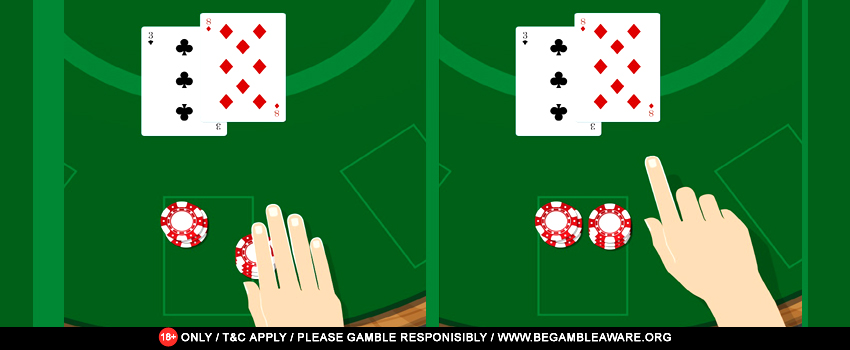Casino rules vary on how many times a player can split his cards. For example, if you draw a pair of eights, split them, and are dealt another eight, most casinos will allow to you split again and start a third hand. Ask the dealer what the split rules are if you do not know them. So that’s how blackjack is played.
- Appendices
- Miscellaneous
- External Links
On This Page

Introduction

To use the basic strategy, look up your hand along the left vertical edge and the dealer's up card along the top. In both cases an A stands for ace. From top to bottom are the hard totals, soft totals, and splittable hands. There are two charts depending on whether the dealer hits or stands on soft 17. Triple strike slot machine wins.
- In a No-Hole-Card game, a player might split or double and have multiple bets at risk to a dealer blackjack, because the dealer cannot check ahead of time. This changes the optimal strategy, and means that players should usually not split or double against a dealer ten or Ace upcard. (An exception is splitting Aces against a dealer ten.).
- You can then act on that hand according to the rules of blackjack by hitting, standing, or doubling down. You can even split the eights a second or third time. This is how aces and eights are handled at the blackjack table according to basic strategy. It is one of the easiest rules to remember at the blackjack table. Always split aces and eights.
Other basic strategy rules.
- Never take insurance or 'even money.'
- If there is no row for splitting (fives and tens), then look up your hand as a hard total (10 or 20).
- If you can't split because of a limit on re-splitting, then look up your hand as a hard total, except aces. In the extremely unlikely event you have a pair of aces you can't re-split and drawing to split aces is allowed, then double against a 5 or 6, otherwise hit.
Ideally, the basic strategy shows the play which, on average, will result in the greatest win or the least loss per initial hand played. The way I usually go about this is to look at the initial 2-card hands only. Generally, this will result in the overall best play. However, soft 18 against a dealer ace when the dealer stands on soft 17 provides the only known exception that I am aware of for any number of decks. As my blackjack appendix 9 shows, a 2-card soft 18 vs A has an expected value of hitting of -0.100359, and of standing -0.100502. So with two cards it is very slightly better to hit. However, not all soft 18's are composed of two cards. The more the cards in the player's hand the more the odds favor standing. Simulations show that if forced to always hit or always stand, it is better to stand. I would like to thank Don Schlesinger for bringing this unusual play to my attention.

Introduction
To use the basic strategy, look up your hand along the left vertical edge and the dealer's up card along the top. In both cases an A stands for ace. From top to bottom are the hard totals, soft totals, and splittable hands. There are two charts depending on whether the dealer hits or stands on soft 17. Triple strike slot machine wins.
- In a No-Hole-Card game, a player might split or double and have multiple bets at risk to a dealer blackjack, because the dealer cannot check ahead of time. This changes the optimal strategy, and means that players should usually not split or double against a dealer ten or Ace upcard. (An exception is splitting Aces against a dealer ten.).
- You can then act on that hand according to the rules of blackjack by hitting, standing, or doubling down. You can even split the eights a second or third time. This is how aces and eights are handled at the blackjack table according to basic strategy. It is one of the easiest rules to remember at the blackjack table. Always split aces and eights.
Other basic strategy rules.
- Never take insurance or 'even money.'
- If there is no row for splitting (fives and tens), then look up your hand as a hard total (10 or 20).
- If you can't split because of a limit on re-splitting, then look up your hand as a hard total, except aces. In the extremely unlikely event you have a pair of aces you can't re-split and drawing to split aces is allowed, then double against a 5 or 6, otherwise hit.
Ideally, the basic strategy shows the play which, on average, will result in the greatest win or the least loss per initial hand played. The way I usually go about this is to look at the initial 2-card hands only. Generally, this will result in the overall best play. However, soft 18 against a dealer ace when the dealer stands on soft 17 provides the only known exception that I am aware of for any number of decks. As my blackjack appendix 9 shows, a 2-card soft 18 vs A has an expected value of hitting of -0.100359, and of standing -0.100502. So with two cards it is very slightly better to hit. However, not all soft 18's are composed of two cards. The more the cards in the player's hand the more the odds favor standing. Simulations show that if forced to always hit or always stand, it is better to stand. I would like to thank Don Schlesinger for bringing this unusual play to my attention.

